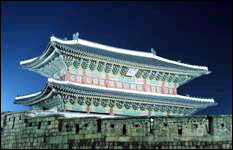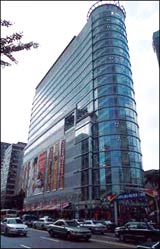|
|
|

Dongdaemun Market, A world-famous fashion market
 ocated near the Dongdaemun (old East Gate) in Seoul, Dongdaemun Market is the place to discover an entire gamut of items, from ancient crafts to the most modern digital equipment, from small, sophisticated accessories to large tools and furniture items. Its growing international reputation brings in droves of shoppers from foreign countries; it is not unusual to see people of many nationalities passing through the bustling aisles of the shopping malls and hunting for high-quality items at satisfying prices. The hectic lifestyles of the merchants, the excitement of pursuing the best bargains, the originality of many young, ambitious designers - this is what today's Dongdaemun Market is about!
ocated near the Dongdaemun (old East Gate) in Seoul, Dongdaemun Market is the place to discover an entire gamut of items, from ancient crafts to the most modern digital equipment, from small, sophisticated accessories to large tools and furniture items. Its growing international reputation brings in droves of shoppers from foreign countries; it is not unusual to see people of many nationalities passing through the bustling aisles of the shopping malls and hunting for high-quality items at satisfying prices. The hectic lifestyles of the merchants, the excitement of pursuing the best bargains, the originality of many young, ambitious designers - this is what today's Dongdaemun Market is about!
Customers can order a new design in the morning and have it by evening. As the oldest and largest wholesale market in Korea, Dongdaemun Market currently includes about 29,000 shops, which gross over 40 billion won (about US$35 million) in sales per day. With the number of people visiting or working in the area totaling 200,000 to 300,000, and foreign shoppers exceeding 2,000 a day, Dongdaemun Market has become an important fashion hub in the region, as well as a major clothing exporter to such markets as China, Japan, Taiwan, Hong Kong and other Southeast Asian nations.
 Dongdaemun Market is divided into several zones according to location and type of goods sold. Briefly, the western part of the market includes recently opened retailers, where the newest trends in fashion can be found, and the Dongdaemun Jonghap Market. The eastern section houses new built wholesaling markets, and traditional markets.
Dongdaemun Market is divided into several zones according to location and type of goods sold. Briefly, the western part of the market includes recently opened retailers, where the newest trends in fashion can be found, and the Dongdaemun Jonghap Market. The eastern section houses new built wholesaling markets, and traditional markets.
In the eastern part of the market are large, recently built wholesale shopping centers such as Designer Club, Team 204, Art Plaza, Uno Core, Hyeyang Elysium, and Apm. Modern buildings of five to fifteen stories house hundreds of shops each. Major customers are retail clothing merchants from Seoul, suburban areas or local provinces who flock to the market, sometimes together in rented buses. Open hours are usually from 8:30 to 9:00 in the evening to 7:00 to 9:00 the next morning, with the peak period being 10 p.m. to 2 a.m. While shops sell mainly clothes, a few specialize in accessories or other auxiliary fashion goods. Some stores do retail business as well, but they are mainly involved in wholesaling or exporting, which account for 86% of sales. They export goods mostly on an OEM basis.
Huge shopping centers such as Freya Town, Migliore, and Doosan Tower are in the western part of the market, high rises, modern both inside and out, with interior layout similar to the department stores. The owners of the shops are mainly ambitious young designers who are sensitive to the newest trends in fashion. About 80% of the merchandise is in line with the new trends in men's and women's casual wears, women's suits, and knitwear. Jeans, sportswear, and leather clothing are also among the major selling items. With a growing number of customers seeking shopping information via the internet, Freya Town operates its own website in Korean, English, Japanese, Chinese and Russian. Doosan Tower also signed a strategic alliance with Samsung Internet Shopping Mall, and opened a cyber shopping mall under the title Doota. Prices are low thanks to lower distribution costs.
 Since the markets for fabrics and notions (buttons, etc.) are located near the site of design, manufacture, and sales, the concentration of functions streamlines the cycle of ordering to delivery of goods, compared with rival markets around the world. Above all, shop owners are young. Of these entrepreneurs, 47.4% are in their 20s and 39.5% are in their 30s. They are deeply involved in every facet of the apparel industry, from planning to distribution. They not only select fabrics and accessories, but are also in contact with factories and designers. Their hands-on management style and their ability to make quick decisions, impossible in big companies, are important factors in their rapid growth. Some designers, also referred to as 'market designers', own their shops, while others work exclusively in one shop or simultaneously for several shops. After the nation was hit by the financial crisis in the late 1990s, many designers who had been studying abroad or were laid off moved into Dongdaemun Market. In addition, since the financial crisis, more consumers are turning to high-quality clothing at reasonable prices, rather than expensive brand-name items.
Since the markets for fabrics and notions (buttons, etc.) are located near the site of design, manufacture, and sales, the concentration of functions streamlines the cycle of ordering to delivery of goods, compared with rival markets around the world. Above all, shop owners are young. Of these entrepreneurs, 47.4% are in their 20s and 39.5% are in their 30s. They are deeply involved in every facet of the apparel industry, from planning to distribution. They not only select fabrics and accessories, but are also in contact with factories and designers. Their hands-on management style and their ability to make quick decisions, impossible in big companies, are important factors in their rapid growth. Some designers, also referred to as 'market designers', own their shops, while others work exclusively in one shop or simultaneously for several shops. After the nation was hit by the financial crisis in the late 1990s, many designers who had been studying abroad or were laid off moved into Dongdaemun Market. In addition, since the financial crisis, more consumers are turning to high-quality clothing at reasonable prices, rather than expensive brand-name items.
Moreover, young consumers seeking more creative fashion designs account for a growing share of the consumer base. Therefore, the demand for creative, capable young designers has been rising. In response, shopping centers in the market are continuously striving to discover and to foster young designers. To that end, Doosan Tower opened Doota on the basement level (430 shops) as a fashion mall targeting young consumers, and it holds the Doota Venture Designer Competition, allowing winners to open their shops in the building. Foreign shoppers spend more than one billion won every year at Dongdaemun Market for clothes, accessories, and other fashion items. In particular, shoppers from Russia, Europe and China are attracted by the low prices, while Japanese and Taiwanese shoppers tend to shop for items geared to the young consumers. Dongdaemun is definitely the place for serious comparisons on price and variety.
english.tour2korea.com
|
|
|
 ocated near the Dongdaemun (old East Gate) in Seoul, Dongdaemun Market is the place to discover an entire gamut of items, from ancient crafts to the most modern digital equipment, from small, sophisticated accessories to large tools and furniture items. Its growing international reputation brings in droves of shoppers from foreign countries; it is not unusual to see people of many nationalities passing through the bustling aisles of the shopping malls and hunting for high-quality items at satisfying prices. The hectic lifestyles of the merchants, the excitement of pursuing the best bargains, the originality of many young, ambitious designers - this is what today's Dongdaemun Market is about!
ocated near the Dongdaemun (old East Gate) in Seoul, Dongdaemun Market is the place to discover an entire gamut of items, from ancient crafts to the most modern digital equipment, from small, sophisticated accessories to large tools and furniture items. Its growing international reputation brings in droves of shoppers from foreign countries; it is not unusual to see people of many nationalities passing through the bustling aisles of the shopping malls and hunting for high-quality items at satisfying prices. The hectic lifestyles of the merchants, the excitement of pursuing the best bargains, the originality of many young, ambitious designers - this is what today's Dongdaemun Market is about!
 Dongdaemun Market is divided into several zones according to location and type of goods sold. Briefly, the western part of the market includes recently opened retailers, where the newest trends in fashion can be found, and the Dongdaemun Jonghap Market. The eastern section houses new built wholesaling markets, and traditional markets.
Dongdaemun Market is divided into several zones according to location and type of goods sold. Briefly, the western part of the market includes recently opened retailers, where the newest trends in fashion can be found, and the Dongdaemun Jonghap Market. The eastern section houses new built wholesaling markets, and traditional markets.
 Since the markets for fabrics and notions (buttons, etc.) are located near the site of design, manufacture, and sales, the concentration of functions streamlines the cycle of ordering to delivery of goods, compared with rival markets around the world. Above all, shop owners are young. Of these entrepreneurs, 47.4% are in their 20s and 39.5% are in their 30s. They are deeply involved in every facet of the apparel industry, from planning to distribution. They not only select fabrics and accessories, but are also in contact with factories and designers. Their hands-on management style and their ability to make quick decisions, impossible in big companies, are important factors in their rapid growth. Some designers, also referred to as 'market designers', own their shops, while others work exclusively in one shop or simultaneously for several shops. After the nation was hit by the financial crisis in the late 1990s, many designers who had been studying abroad or were laid off moved into Dongdaemun Market. In addition, since the financial crisis, more consumers are turning to high-quality clothing at reasonable prices, rather than expensive brand-name items.
Since the markets for fabrics and notions (buttons, etc.) are located near the site of design, manufacture, and sales, the concentration of functions streamlines the cycle of ordering to delivery of goods, compared with rival markets around the world. Above all, shop owners are young. Of these entrepreneurs, 47.4% are in their 20s and 39.5% are in their 30s. They are deeply involved in every facet of the apparel industry, from planning to distribution. They not only select fabrics and accessories, but are also in contact with factories and designers. Their hands-on management style and their ability to make quick decisions, impossible in big companies, are important factors in their rapid growth. Some designers, also referred to as 'market designers', own their shops, while others work exclusively in one shop or simultaneously for several shops. After the nation was hit by the financial crisis in the late 1990s, many designers who had been studying abroad or were laid off moved into Dongdaemun Market. In addition, since the financial crisis, more consumers are turning to high-quality clothing at reasonable prices, rather than expensive brand-name items.